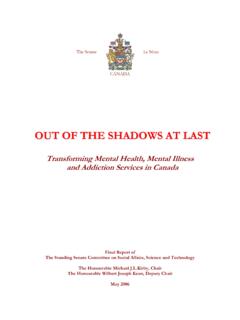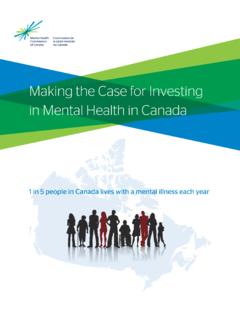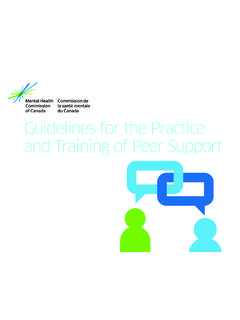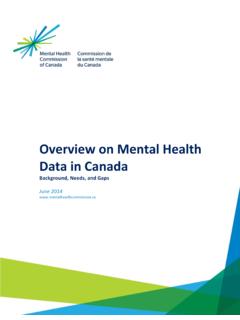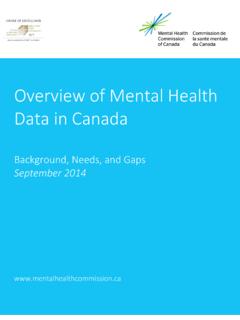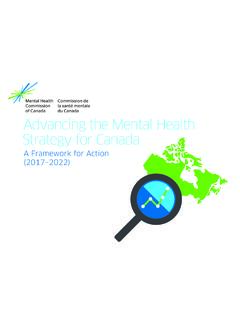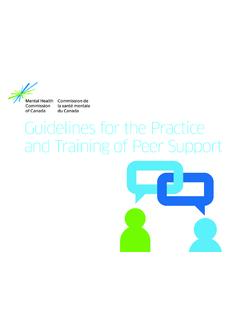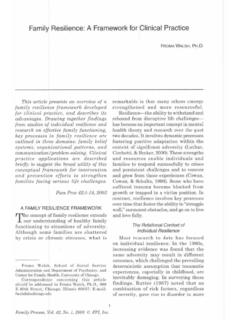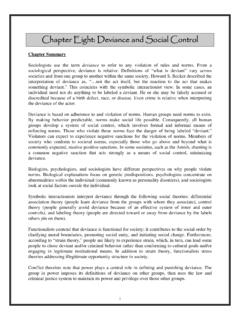Transcription of RESEARCH ON SUICIDE AND ITS PREVENTION
1 RESEARCH ON SUICIDE AND ITS PREVENTION : What the current evidence reveals and topics for future researchDecember 2018 The following is an interpretation of a literature review commissioned by the Mental Health Commission of Canada and the Public Health Agency of Canada and produced by the Quebec Network on SUICIDE , Mood Disorders, and Related Disorders. Ce document est disponible en fran citationMental Health Commission of Canada. (2018). RESEARCH on SUICIDE and its PREVENTION : What the current evidence reveals and topics for future RESEARCH . Ottawa, document is available at 2018 Mental Health Commission of views represented herein solely represent the views of the Mental Health Commission of of this document is made possible through a financial contribution from Health : 978-1-77318-089-2 Legal deposit: National Library of of contentsI.
2 Terminology of SUICIDE and suicidal behaviours 1II. Executive summary 2 RESEARCH on SUICIDE at the international level: Where are we today, and where do we need to go? 2 Recommendations for future RESEARCH : 6 III. Summary report 8 Why was the scoping review commissioned? 8 How was the scoping review conducted? 9 Limitations of the RESEARCH 10 What the current evidence reveals 11 Recommendations for future RESEARCH 16 Canadian and international contributions to RESEARCH on SUICIDE and its PREVENTION 18 Conclusion and recommendations for future RESEARCH 20 APPENDIX 1: STUDY HIGHLIGHTS 221 RESEARCH on SUICIDE and its PREVENTION :What the current evidence reveals and topics for future researchI. Terminology of SUICIDE and suicidal behavioursSeveral terms have been used to describe suicidal and self-harming behaviours in the scientific literature.
3 To allow meaningful comparisons, consensus definitions of international terminology are important. Definitions of terms used in the literature to describe thoughts of SUICIDE and suicidal behaviours are outlined in the table below. Due to the lack of an accepted and standardized international terminology, articles included in this report have used varying terms and for accuracy purposes, results were described using the terminology used by original study fatal self-injurious act with some evidence of intent to dieSuicidal behaviourRanges from thoughts of SUICIDE to SUICIDE attempts to death by suicideSuicide attemptA potentially self-injurious behaviour associated with some intent to dieActive thoughts of suicideThoughts about taking action to end one s life, which may include.
4 Identifying a method, having a plan, and/or having intent to actPassive thoughts of suicideThoughts about death, or wanting to be dead, without any plan or intentNon-suicidal self-injurySelf-injurious behaviour with no intent to dieSuicidal eventsThe onset or worsening of thoughts of SUICIDE or an actual SUICIDE attempt or an emergency referral for thoughts of SUICIDE or suicidal behaviourDeliberate self-harmAny type of self-injurious behaviour, including thoughts of SUICIDE without the intent to die2 RESEARCH on SUICIDE and its PREVENTION :What the current evidence reveals and topics for future researchII. Executive SummaryWhat does the current evidence tell us about SUICIDE , and what can be done to prevent suicidal behaviours? Where are the evidence gaps when it comes to fully understanding the complex and often interacting factors that drive individuals to self-harming behaviours, and what are the most appropriate and effective tools to assist them?
5 To help answer these questions, the Mental Health Commission of Canada (MHCC) and the Public Health Agency of Canada (PHAC) commissioned the Quebec Network on SUICIDE , Mood Disorders and Related Disorders to conduct a review of the scientific literature on SUICIDE and SUICIDE PREVENTION as part of MHCC and PHAC s co-lead initiative aimed at building a shared Canadian RESEARCH agenda on SUICIDE and its PREVENTION . An extensive international literature search from 2000-2016 on SUICIDE and its PREVENTION was conducted drawing on published scientific papers produced by researchers internationally, including Canada. Articles published in 2017 were excluded as this represents a partial year and would skew the interpretation of results. An initial review of the literature pertaining to any aspect of RESEARCH on SUICIDE and its PREVENTION yielded nearly million articles.
6 The search was narrowed by using three databases (MEDLINE-PubMed, PsycINFO and CINAHL) and including just two types of articles recognized for generally providing higher quality and relevant results: systematic reviews which incorporate findings from several primary studies, and meta-analyses which combine the results of multiple studies identified in a systematic review Using this approach, 867 scientific studies published between 2000 and 2016 were selected and a 446-page report detailing the findings was produced. A limitation of the international literature search is the exclusion of knowledge not captured in systematic reviews or meta-analyses ( emerging fields, non-scientific evidence, unpublished or non-peer reviewed knowledge and qualitative studies).
7 The MHCC has chosen some main findings to highlight by way of this summary paper, and the following represents an interpretation of the main findings from the scoping review. To access the full report (currently available in English only), please contact RESEARCH on SUICIDE at the international level: Where are we today, and where do we need to go? RESEARCH on SUICIDE and suicidal behaviour has increased over the last 15 years on many fronts, from the clinical, social and psychological aspects to the greater environment and population-level influences, such as access to mental health care. 3 RESEARCH on SUICIDE and its PREVENTION :What the current evidence reveals and topics for future researchCanada has been a significant contributor to RESEARCH on SUICIDE and its PREVENTION internationally, with the country s share of scientific publications increasing from just over 2% in 2000 to more than 6% in 2015.
8 In specific areas of expertise including genetics, epigenetics, Indigenous mental health, and others, Canadian researchers are responsible for over a third of international RESEARCH . Canadian RESEARCH has strength in sub-specialities within the field of RESEARCH on SUICIDE and its the factors that contribute to SUICIDE and suicidal behaviour, as well as potential solutions, are complex and While there is no solution that guarantees the PREVENTION of SUICIDE , a review of Canadian and international scientific literature identified the most relevant current knowledge about the factors associated with SUICIDE and strategies for its PREVENTION . The review also highlighted programs and recommendations with regards to addressing RESEARCH gaps that could help to inform future policies and procedures aimed at reducing the risk of SUICIDE among different of Risk Factors for SUICIDE and/or Suicidal Behaviour * Note: The following are not ranked in orderMale ( SUICIDE )Female (suicidal behaviour)AdolescentHistory of suicidal behaviourExposure to violence (bullying, child abuse)Season (spring, summer)People receiving inpatient careFamily history of psychiatric disorder/suicideAlcohol/substance useIncarcerationSocial factors: Loneliness, recent life eventsOccupation.
9 Physician (especially female) Police First responderInternet and media information ( , exposure to sensationalized celebrity SUICIDE )4 RESEARCH on SUICIDE and its PREVENTION :What the current evidence reveals and topics for future researchSummary of Risk Factors for SUICIDE and/or Suicidal Behaviour * Note: The following are not ranked in orderComorbid diseasePsychiatric disorders: Affective disorders (depression) Substance use disorders Psychotic disorders Personality disorders (borderline personality disorder) Anorexia Post-traumatic stress disorder Bipolar disorder (children and youth) attention deficit hyperactivity disorder (ADHD; children and youth) Conduct disorder (children and youth)Somatic conditions: Underweight Physical pain (any type) (suicidal ideation and behaviour) Previous abortion (suicidal behaviour) HIV+ (suicidal ideation and self-harm)Socio-economic situation: Marital status young, unmarried (suicidal behaviour) Socio-economic insecurity Unemployment Lower education Family structure Maternal emotional unavailability Separated or divorced5 RESEARCH on SUICIDE and its PREVENTION :What the current evidence reveals and topics for future researchSummary of Risk Factors for SUICIDE and/or Suicidal Behaviour * Note: The following are not ranked in orderOther brain disorders.
10 Traumatic brain disorder Intellectual disabilities Autism spectrum disorders Multiple sclerosis Epilepsy Cognitive deficit or decline (elderly)Minority groups: Among immigrant populations, SUICIDE risk is closely associated with country of origin Lesbian, gay, and bisexual (articles reviewed did not include transgender or questioning populations) Indigenous (especially youth)Personality and psychological traits: Hopelessness Impulsivity Neuroticism AnxietySummary of Protective Factors * Note: The following are not ranked in orderCountry of origin among immigrants, if country of origin has lower SUICIDE /suicidal behaviour risk6 RESEARCH on SUICIDE and its PREVENTION :What the current evidence reveals and topics for future researchSummary of Protective Factors * Note: The following are not ranked in orderSocial factors: Socio-economic situation Loving parent-child relationship Having reasons for living Social connectedness Sense of belonging ReligionTreatment: Selective serotonin reuptake inhibitors Ketamine Lithium for mood disorders Dialectical-behaviour therapy Internet-based Cognitive Behavioural Therapy (CBT) in depression Follow-up interventions Active contact and follow-upRecommendations for future RESEARCH : There are many promising findings in RESEARCH on SUICIDE , particularly in the areas of PREVENTION and intervention trials.
